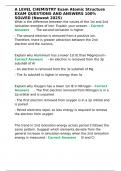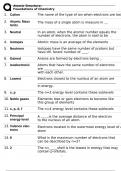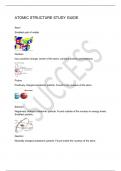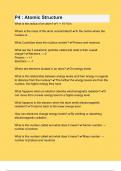Atomic structure - Samenvattingen en Aantekeningen
Op zoek naar een samenvatting over Atomic structure? Op deze pagina vind je 3713 samenvattingen over Atomic structure.
Pagina 3 van de 3.713 resultaten
Sorteer op
A LEVEL CHEMISTRY Exam Atomic Structure EXAM QUESTIONS AND ANSWERS 100- SOLVED (Newest
Atomic Structure: Foundations of Chemistry (Unit 2)
ATOMIC STRUCTURE STUDY GUIDE
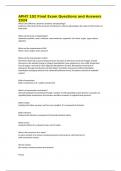
-
APHY 102 Final Exam Questions and Answers 2024
- Tentamen (uitwerkingen) • 23 pagina's • 2024
- Ook in voordeelbundel
-
 StudyHubSolutions
StudyHubSolutions
-
- $10.69
- 1x verkocht
- + meer info
APHY 102 Final Exam Questions and Answers 2024 What is the difference between anatomy and physiology? Anatomy is the study of the structure of body parts, whereas physiology is the study of the function of body parts What are the levels of organization? subatomic particles, atom, molecule, macromolecule, organelle, cell, tissue, organ, organ system, organism What are the requirements of life? Water, food, oxygen, heat, pressure What are the characteristics of life? Movement (...

-
2024 AQA GCSE Chemistry - Paper 1. Exam Questions with Complete Solutions Merged (Verified)
- Tentamen (uitwerkingen) • 26 pagina's • 2024
-
 Besttutors
Besttutors
-
- $11.49
- 1x verkocht
- + meer info
Atom definition The smallest component of an element Compound Two or more elements, chemically joined in fixed proportions. They can only be separated by chemical means. Mixture Two or more elements/compounds which are not chemically combined. Ways to separate mixtures - Filtration - Evaporation - Crystallisation - Simple distillation - Fractional distillation - Paper chromatography The plum and pudding model Before electrons were discovered, people thought that atoms were indivi...

-
BIO 210 - FINAL EXAM REVIEW QUESTIONS WITH 100 % CORRECT ANSWERS | VERIFIED
- Tentamen (uitwerkingen) • 13 pagina's • 2024
- Ook in voordeelbundel
-
 PatrickKaylian
PatrickKaylian
-
- $7.99
- 1x verkocht
- + meer info
Anatomy - Answer-the study of structure Physiology - Answer-the study of function Metabolism - Answer-all the chemical reactions that happen in our body cells Catabolism - Answer-the breakdown of complex molecules into simpler ones. Catabolic reaction Anabolism - Answer-The building up of complex molecules from simpler ones Levels of Structural Organization - Answer-Atom (chemical), Molecule (chemical), Cell tissue, Organ, Organ System, Organism Homeostasis - Answer-The maintenance of the...

-
Test Bank Memmlers Structure and Function of the Human Body 12th Edition Cohen
- Tentamen (uitwerkingen) • 848 pagina's • 2024
-
 solver
solver
-
- $17.99
- 2x verkocht
- + meer info
Test Bank Memmlers Structure and Function of the Human Body 12th Edition Cohen Chapter 01: Introduction to the Body MULTIPLE CHOICE 1. The word derived from two word parts that mean ―cutting apart‖ is a. physiology b. homeostasis c. anatomy d. dissection ANS: C DIF: Memorization REF: p. 3 OBJ: 1 TOP: Introduction 2. The study of how the body functions is called a. physiology b. homeostasis c. anatomy d. dissection ANS: A DIF: Memorization REF: p. 3 OBJ: 1 TOP: Introduction 3. The correct seq...
P4 Atomic Structure Questions with 100% Correct
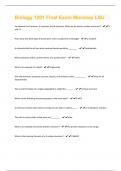
-
Biology 1201 Final Exam Moroney LSU Questions With Correct Answers!!
- Tentamen (uitwerkingen) • 12 pagina's • 2023
- Ook in voordeelbundel
-
 PatrickKaylian
PatrickKaylian
-
- $7.99
- 2x verkocht
- + meer info
An element has 8 protons, 9 neutrons, and 8 electrons. What are its atomic number and mass? - 8 and 17 How many and what type of bonds does sulfur usually form in biology? - 2 covalent A molecule that has all non polar covalent bonds would be________. - hydrophobic What substance makes up the interior of a potato tuber? - starch What is an example of a lipid? - triglyceride One characteristic shared by sucrose, lactose, and maltose is that __________. -they are all dissacharides The over...

-
CHAPTER 1_ ATOMIC STRUCTURE AND PERIODIC TRENDS Questions
- Tentamen (uitwerkingen) • 8 pagina's • 2024
- Ook in voordeelbundel
-
 DoctorHkane
DoctorHkane
-
- $7.99
- + meer info
CHAPTER 1_ ATOMIC STRUCTURE AND PERIODIC TRENDS Questions

Wist je dat een verkoper gemiddeld €76 per maand verdient met het verkopen van samenvattingen? Hint, hint. Ontdek alles over verdienen op Stuvia

